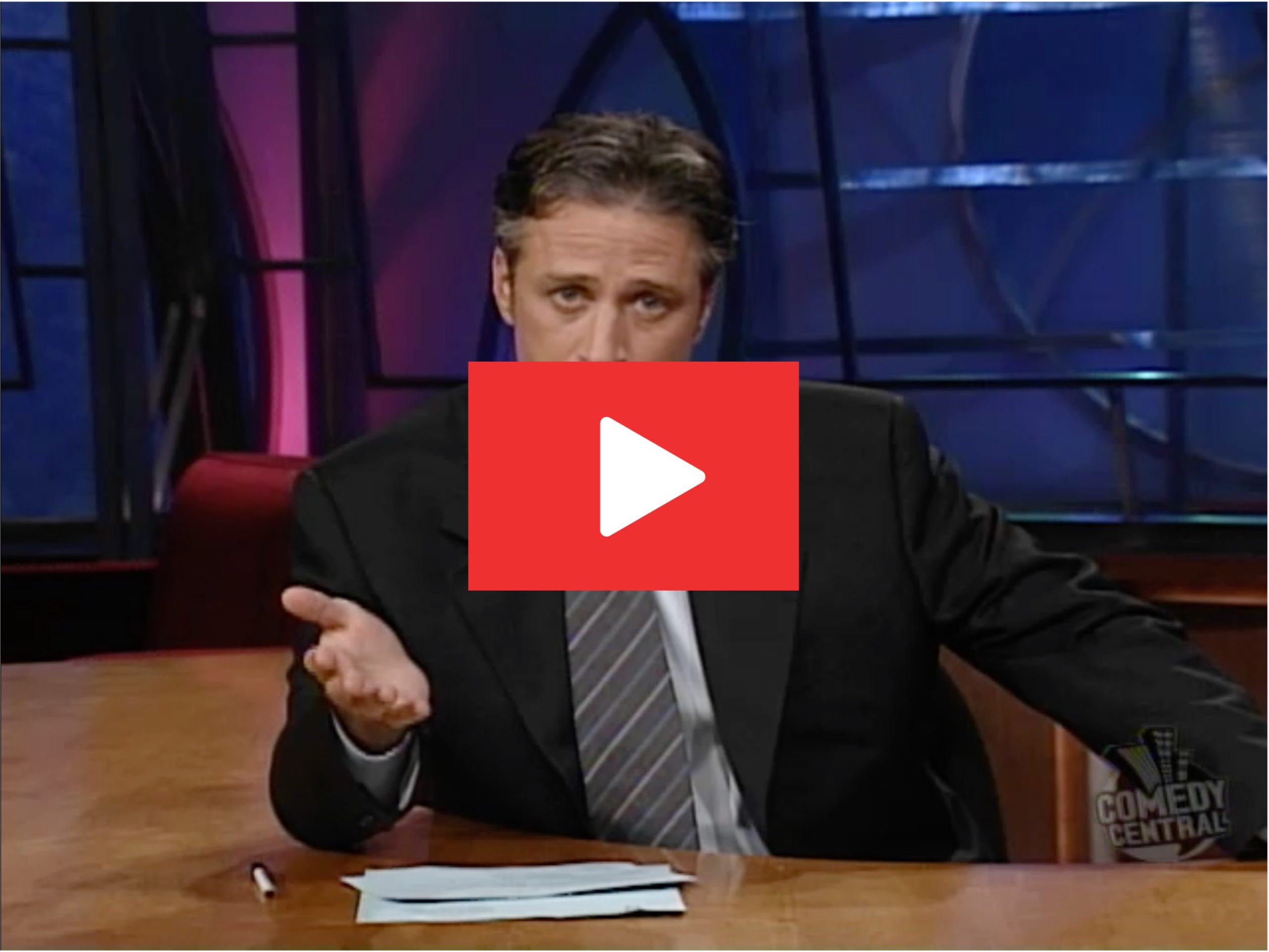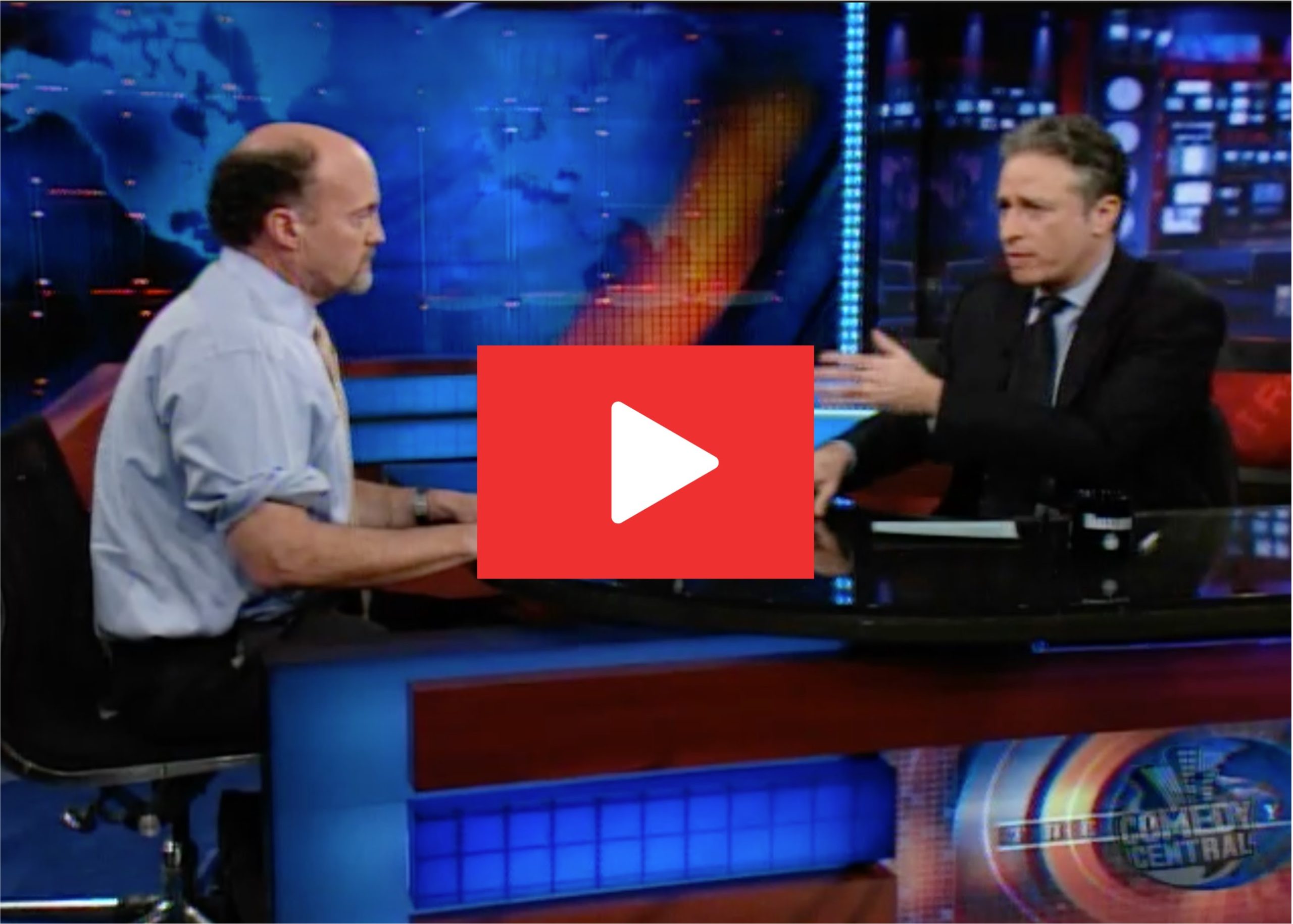
🏆 Recognizing #StoriesThatMatter. Never miss a newsletter! Sign up and have #PeabodyFinds delivered to your inbox.
Jon Stewart arrived at the intersection of entertainment and politics in 1999, and made The Daily Show proof that the two were never meant to be separate. He’d inherited a show format—namely, fake news—from previous host Craig Kilborn, who’d inaugurated it on Comedy Central in 1996. But Stewart injected that format with not just humor and silly satire, but also a willingness to call things like he saw them, speaking truth to the power of slippery politicians and irresponsible media–particularly cable news, and more particularly, Fox News.
He would go on to become a liberal icon of the Bush years, a voice of reason in the wake of 9/11, and a fierce advocate for, most notably, that disaster’s first responders as they suffered from dire health effects. During his Peabody-winning time at the anchor desk, the show grew to be a major source of information about politics and public affairs for what was then the youth vote, disaffected Gen Xers desperate for Stewart’s brand of cutting through the BS. One Pew survey named him as among young people’s most trusted journalists, even though he refused to embrace that title himself.
The now-61-year-old left his trademark show before the 2016 election, ceding his seat to the charming South African comedian Trevor Noah just in time for the implosion that was Donald Trump’s ascension to U.S. president. In Stewart’s wake flourished a bounty of riffs on The Daily Show format, including This Week Tonight with John Oliver and Full Frontal with Samantha Bee, as well as traditional network late-night shows rejiggered in its image, including The Late Show with Stephen Colbert and Late Night with Seth Meyers. Everything has changed in the interim when it comes to politics and media: Trump upended everything most of us thought about politics; media has been dwindling, fragmenting, and morphing ever since; we’ve survived a global pandemic; polarization and disinformation have run amok.
Stewart, meanwhile, launched a show on Apple TV+, The Problem with Jon Stewart, on which he affected a very different approach, as a quite serious and sometimes angry, left-wing warrior who made only occasional jokes. Each episode focused on a specific issue, with Stewart making his own stance quite clear and engaging in panel discussions as well as often-confrontational interviews. He tackled veterans’ harrowing health problems stemming from the practice of burn pits, the government’s propensity to bail out large corporations while deriding assistance to the working class, and media hypocrisy in climate change coverage. The show didn’t make nearly the splash that The Daily Show, and it was canceled in October due to his coverage of China and AI, topics the streamer would have rather he didn’t touch.
Stewart has now returned to the site of his original triumph, The Daily Show, hosting weekly on Mondays (with rotating hosts the rest of the week) and executive producing. And, remarkably, he seems to have revived his old persona, with the jokes, timing, and middle-of-the-road sensibility of pre-2016 Stewart immediately activated upon his return to his old desk.
His homecoming has been cheered with hopes that it will energize a presidential contest between two former presidents and octo- and near-octo-generians. NPR’s Eric Deggans, a former Peabody juror, reviewed Stewart’s return on February 12 favorably: “From the show’s opening moments, Stewart eased back into the host’s chair without missing a beat, firing off jokes with a familiar style that felt like he had left just a few weeks ago, rather than in 2015. He brought a confidence the program sorely needs; it’s been searching for a permanent host for more than a year since the departure of Trevor Noah, who succeeded Stewart as host.” The reunion of Stewart and The Daily Show has proven a win-win when it comes to ratings: His first episode back drew 1.85 million viewers, up 110 percent over Noah’s final episode in 2022, and more than four times The Problem’s audience.
He came in clearly determined to show his willingness to take swings at both sides, questioning the cognitive shortcomings of President Joe Biden as well as presumed Republican opponent Donald Trump in his first week. Then, in his second week, Stewart played clips of Democrats panning his return. He defended his stance as “just talking here,” adding, sarcastically, “But I guess, as the famous saying goes, democracy dies in discussion.” He has emphasized his belief in the democratic power of debate more than once while addressing his decision to return: “You have to be present in this conversation,” he said on The Daily Show podcast, “and you have to be as relentless and as tenacious as the counternarrative that’s being formed.”
To celebrate Stewart’s return to the desk, we’re looking back on five of his greatest moments to remember what a huge cultural and political force he’s capable of being.
Where to Watch: CC.com
Covering ‘Indecision 2000’
The Daily Show’s “Indecision” designation for election coverage began with the progenitor of indecisive-ish U.S. presidential elections, Bush v. Gore. This is what won the show one of its Peabodys, in fact. “The photo finish that is the 2000 presidential election will ultimately be decided by Florida judges, dimpled chads and accounting skills of part-time municipal employees,” Stewart said in one piece. “It’s a stunning struggle for democracy centered on a small group of Florida voters; people who may get to determine the next presidential administration, but probably won’t have to live through it.” This was the moment when mainstream shows like Today began to call on Stewart as a pundit.
Reacting to 9/11
Stewart’s first show back after 9/11 featured a bracing, very unfunny, very heartfelt monologue that addressed the tragedy directly, an act that felt deeply appreciated at a time when many in entertainment were dithering about the “correct response.” But Stewart didn’t leave his sentiment there. He has gone on to fight for the rights of and government benefits for 9/11 first responders in a way that has kept them in the news long after the tragedy’s burn subsided for most Americans. It has also translated to real life, sending the “fake news” anchor to courtrooms and Congress in a way that has yielded actual results.
Presenting the ‘Go F*** Yourself’ Choir
If you want to know where John Oliver‘s more outrageous political stunts began, it’s here. In 2010, Stewart brought an actual professional choir in to sing “Go F— Yourself” to his perennial nemesis, Fox News. In 2013, the choir returned after Stewart’s Daily Show poked fun at the “Obamacare” website’s widespread technical failings, and Fox News and its ilk cited this as evidence against the entire concept of a slightly more national health care system. Delivering this particular musical message to Fox News felt bigger than any one incident, and quite satisfying to the kind of people who watched The Daily Show regularly.
Calling Tucker Carlson a ‘D***’
Stewart recently took down Carlson’s interview with Russian President Vladimir Putin. Seemed like low-hanging fruit for a number of reasons, but most notably the fact that once upon a time, Stewart took down Carlson when it counted more. In 2004, Stewart appeared on Carlson’s CNN show Crossfire, calling the hosts “partisan hacks” and Carlson a “d***” and blaming the show for purposefully inflaming divisiveness. Carlson would later go on to the much more partisan Fox News.
Taking Down CNBC’s Jim Cramer
In the wake of the 2008 financial crisis, CNBC Mad Money host Jim Cramer appeared as a guest on The Daily Show, and found himself under tougher questioning than he appeared to expect. Stewart used the show’s classic trick for exposing hypocrisy—rolling tape that contradicts what someone has just said. This time, unlike many others, he did it while that person was sitting across from him, showing Cramer on video talking about his shady hedge fund dealings. At a time when people were losing houses, retirement savings, and fortunes due to financial tricksters, the exchange felt like at least one small comeuppance.
Stewart’s Peabody Acceptance for ‘The Daily Show’
“It is my 16th wedding anniversary. My wife is here, and every year on our anniversary … I try to get her a prestigious award, and every year I fail. This is the first year where it’s actually worked out.”
Where to Watch: PeabodyAwards.com



